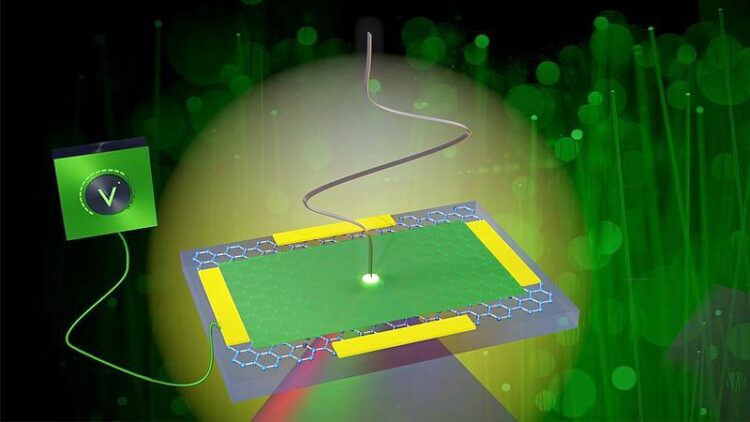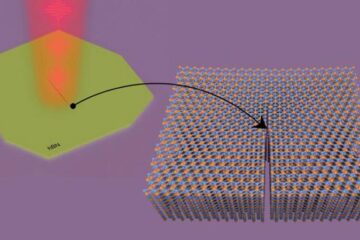Ultrafast and tunable

A graphene-based material converts incoming terahertz pulses (from above) into visible light in an ultrafast and controllable manner - optimal for data transport in optical fibers.
Credit: B. Schröder / HZDR
Terahertz-to-visible light conversion for future telecommunications.
A study carried out by a research team from the Helmholtz-Zentrum Dresden-Rossendorf (HZDR), the Catalan Institute of Nanoscience and Nanotechnology (ICN2), University of Exeter Centre for Graphene Science, and TU Eindhoven demonstrates that graphene-based materials can be used to efficiently convert high-frequency signals into visible light, and that this mechanism is ultrafast and tunable, as the team presents its findings in Nano Letters (DOI: 10.1021/acs.nanolett.3c00507). These outcomes open the path to exciting applications in near-future information and communication technologies.
The ability to convert signals from one frequency regime to another is key to various technologies, in particular in telecommunications, where, for example, data processed by electronic devices are often transmitted as optical signals through glass fibers. To enable significantly higher data transmission rates future 6G wireless communication systems will need to extend the carrier frequency above 100 gigahertz up to the terahertz range. Terahertz waves are a part of the electromagnetic spectrum that lies between microwaves and infrared light. However, terahertz waves can only be used to transport data wirelessly over very limited distances. “Therefore, a fast and controllable mechanism to convert terahertz waves into visible or infrared light will be required, which can be transported via optical fibers. Imaging and sensing technologies could also benefit from such a mechanism,” says Dr. Igor Ilyakov of the Institute of Radiation Physics at HZDR.
What is missing so far is a material that is capable of upconverting photon energies by a factor of about 1000. The team has only recently identified the strong nonlinear response of so-called Dirac quantum materials, e.g. graphene and topological insulators, to terahertz light pulses. “This manifests in the highly efficient generation of high harmonics, that is, light with a multiple of the original laser frequency. These harmonics are still within the terahertz range, however, there were also first observations of visible light emission from graphene upon infrared and terahertz excitation,” recalls Dr. Sergey Kovalev of the Institute of Radiation Physics at HZDR. “Until now, this effect has been extremely inefficient, and the underlying physical mechanism unknown.”
The mechanism behind
The new results provide a physical explanation for this mechanism and show how the light emission can be strongly enhanced by using highly doped graphene or by using a grating-graphene metamaterial – a material with a tailored structure characterized by special optical, electrical or magnetic properties. The team also observed that the conversion occurs very rapidly – on the sub-nanosecond time scale, and that it can be controlled by electrostatic gating.
“We ascribe the light frequency conversion in graphene to a terahertz-induced thermal radiation mechanism, that is, the charge carriers absorb electromagnetic energy from the incident terahertz field. The absorbed energy rapidly distributes in the material, leading to carrier heating; and finally this leads to emission of photons in the visible spectrum, quite like light emitted by any heated object,” explains Prof. Klaas-Jan Tielrooij of ICN2’s Ultrafast Dynamics in Nanoscale Systems group and Eindhoven University of Technology.
The tunability and speed of the terahertz-to-visible light conversion achieved in graphene-based materials has great potential for application in information and communication technologies. The underlying ultrafast thermodynamic mechanism could certainly produce an impact on terahertz-to-telecom interconnects, as well as in any technology that requires ultrafast frequency conversion of signals.
Publication:
I. Ilyakov, A. Ponomaryov, D. Saleta Reig, C. Murphy, J. D. Mehew, T. V.A.G. de Oliveira, G. L. Prajapati, A. Arshad, J.-C. Deinert, M. F. Craciun, S. Russo, S. Kovalev, and K.-J. Tielrooij, Ultrafast Tunable Terahertz-to-Visible Light Conversion through Thermal Radiation from Graphene Metamaterials, Nano Letters, 2023 (DOI: 10.1021/acs.nanolett.3c00507)
Further information:
Dr. Igor Ilyakov | Dr. Sergey Kovalev
Institute of Radiation Physics at HZDR
Phone: +49 351 260 3616 | +49 351 260 2454
Email: i.ilyakov@hzdr.de| s.kovalev@hzdr.de
Media contact:
Simon Schmitt | Head
Communications and Media Relations at HZDR
Phone: +49 351 260 3400 | Email: s.schmitt@hzdr.de
The Helmholtz-Zentrum Dresden-Rossendorf (HZDR) performs – as an independent German research center – research in the fields of energy, health, and matter. We focus on answering the following questions:
• How can energy and resources be utilized in an efficient, safe, and sustainable way?
• How can malignant tumors be more precisely visualized, characterized, and more effectively treated?
• How do matter and materials behave under the influence of strong fields and in smallest dimensions?
To help answer these research questions, HZDR operates large-scale facilities, which are also used by visiting researchers: the Ion Beam Center, the Dresden High Magnetic Field Laboratory and the ELBE Center for High-Power Radiation Sources.
HZDR is a member of the Helmholtz Association and has six sites (Dresden, Freiberg, Görlitz, Grenoble, Leipzig, Schenefeld near Hamburg) with almost 1,500 members of staff, of whom about 670 are scientists, including 220 Ph.D. candidates.
Wissenschaftliche Ansprechpartner:
Dr. Igor Ilyakov | Dr. Sergey Kovalev
Institute of Radiation Physics at HZDR
Phone: +49 351 260 3616 | +49 351 260 2454
Email: i.ilyakov@hzdr.de| s.kovalev@hzdr.de
Originalpublikation:
I. Ilyakov, A. Ponomaryov, D. Saleta Reig, C. Murphy, J. D. Mehew, T. V.A.G. de Oliveira, G. L. Prajapati, A. Arshad, J.-C. Deinert, M. F. Craciun, S. Russo, S. Kovalev, and K.-J. Tielrooij, Ultrafast Tunable Terahertz-to-Visible Light Conversion through Thermal Radiation from Graphene Metamaterials, Nano Letters, 2023 (DOI: 10.1021/acs.nanolett.3c00507)
Weitere Informationen:
Media Contact
All latest news from the category: Information Technology
Here you can find a summary of innovations in the fields of information and data processing and up-to-date developments on IT equipment and hardware.
This area covers topics such as IT services, IT architectures, IT management and telecommunications.
Newest articles

Attosecond core-level spectroscopy reveals real-time molecular dynamics
Chemical reactions are complex mechanisms. Many different dynamical processes are involved, affecting both the electrons and the nucleus of the present atoms. Very often the strongly coupled electron and nuclear…

Columbia researchers “unzip” 2D materials with lasers
The new technique can modify the nanostructure of bulk and 2D crystals without a cleanroom or expensive etching equipment. In a new paper published on May 1 in the journal…

Decoding development: mRNA’s role in embryo formation
A new study at Hebrew University reveals insights into mRNA regulation during embryonic development. The study combines single-cell RNA-Seq and metabolic labeling in zebrafish embryos, distinguishing between newly-transcribed and pre-existing…





















